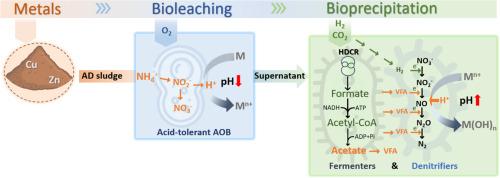Efficient metal removal from digested sludge and supernatant by nitrification-driven acidifying leaching and denitrification-driven alkalizing precipitation
IF 12.4
1区 环境科学与生态学
Q1 ENGINEERING, ENVIRONMENTAL
引用次数: 0
Abstract
The transfer of heavy metals from wastewater to sludge necessitates proper sludge management. This study proposed a two-step bioprocess, utilizing pH variations during nitrification (decreasing pH) and denitrification (increasing pH) to achieve heavy metals removal from digested sludge and supernatant, alongside simultaneous nitrogen removal in the sludge supernatant. In the first stage, digested sludge was acidified to a pH of approximately 2 through ammonia oxidation, facilitated by acid-tolerant ammonia-oxidizing bacteria (AOB). This step resulted in metal solubilization efficiencies of 84.1 ± 2.5% for Cu, 94.5 ± 2.3% for Zn, 83.9 ± 2.5% for Mg, and 72.3 ± 2.2% for Al. In the second stage, the metal ions and nitrogen-rich sludge supernatant derived from bioleaching were introduced into a hydrogen/carbon dioxide (H2/CO2)-based membrane biofilm reactor (MBfR). During this process, denitrification raised the pH to above 7, leading to nitrogen removal efficiencies exceeding 90% and the precipitation of over 90% of Cu, Zn, and Al. Long-term operation of the system revealed the presence of volatile fatty acids (VFAs) in MBfR, which functioned as secondary electron donors alongside hydrogen, as confirmed by in situ batch assays. Furthermore, microbial analysis identified denitrifiers (e.g., Comamonas, Denitratisoma) and fermenters (e.g., Sporomusa) within the biofilm, substantiating the biological processes underpinning the treatment. Overall, this two-step biological treatment effectively removed metals from sludge without reliance on external acids or alkalis, which promotes sustainable waste management practices.

硝化驱动酸化浸出和反硝化驱动碱化沉淀对消化污泥和上清中金属的高效去除
重金属从废水到污泥的转移需要适当的污泥管理。本研究提出了一种两步生物工艺,利用硝化过程中的pH变化(降低pH)和反硝化(增加pH)来去除消化污泥和上清液中的重金属,同时去除污泥上清液中的氮。在第一阶段,消化污泥在耐酸氨氧化菌(AOB)的促进下通过氨氧化酸化至pH约为2。该步骤对Cu、Zn、Mg和Al的金属增溶效率分别为84.1±2.5%、94.5±2.3%、83.9±2.5%和72.3±2.2%。第二阶段,将生物浸出的金属离子和富氮污泥上清液引入氢/二氧化碳(H2/CO2)基膜生物膜反应器(MBfR)。在此过程中,反硝化将pH提高到7以上,导致氮的去除效率超过90%,Cu, Zn和Al的沉淀超过90%。系统的长期运行表明,MBfR中存在挥发性脂肪酸(VFAs),与氢一起作为二级电子供体,原位批量测定证实了这一点。此外,微生物分析确定了生物膜内的反硝化菌(例如,单胞菌,脱硝菌)和发酵菌(例如,孢子菌),证实了支撑处理的生物过程。总的来说,这种两步生物处理有效地从污泥中去除金属,而不依赖于外部酸或碱,这促进了可持续的废物管理实践。
本文章由计算机程序翻译,如有差异,请以英文原文为准。
求助全文
约1分钟内获得全文
求助全文
来源期刊

Water Research
环境科学-工程:环境
CiteScore
20.80
自引率
9.40%
发文量
1307
审稿时长
38 days
期刊介绍:
Water Research, along with its open access companion journal Water Research X, serves as a platform for publishing original research papers covering various aspects of the science and technology related to the anthropogenic water cycle, water quality, and its management worldwide. The audience targeted by the journal comprises biologists, chemical engineers, chemists, civil engineers, environmental engineers, limnologists, and microbiologists. The scope of the journal include:
•Treatment processes for water and wastewaters (municipal, agricultural, industrial, and on-site treatment), including resource recovery and residuals management;
•Urban hydrology including sewer systems, stormwater management, and green infrastructure;
•Drinking water treatment and distribution;
•Potable and non-potable water reuse;
•Sanitation, public health, and risk assessment;
•Anaerobic digestion, solid and hazardous waste management, including source characterization and the effects and control of leachates and gaseous emissions;
•Contaminants (chemical, microbial, anthropogenic particles such as nanoparticles or microplastics) and related water quality sensing, monitoring, fate, and assessment;
•Anthropogenic impacts on inland, tidal, coastal and urban waters, focusing on surface and ground waters, and point and non-point sources of pollution;
•Environmental restoration, linked to surface water, groundwater and groundwater remediation;
•Analysis of the interfaces between sediments and water, and between water and atmosphere, focusing specifically on anthropogenic impacts;
•Mathematical modelling, systems analysis, machine learning, and beneficial use of big data related to the anthropogenic water cycle;
•Socio-economic, policy, and regulations studies.
 求助内容:
求助内容: 应助结果提醒方式:
应助结果提醒方式:


